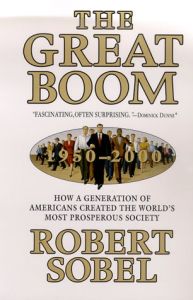Join getAbstract to access the summary!

Join getAbstract to access the summary!
Robert Sobel
The Great Boom
How a Generation of Americans Created the World's Most Prosperous Society
St. Martin’s Press, 2000
What's inside?
When Johnny came marching home, he brought with him the key to the United States’ current prosperity.
Recommendation
How did the modern United States get so rich? Robert Sobel presents an overview of American history from the end of World War II to the present, focusing on the economic, social, and technological developments that built wealth in America. The book is an engaging read, especially for anyone who grew up in the early ’40s or ’50s. Sobel, a professor of business history, wrestles a mass of historical data to the ground, though he sometimes daunts the reader with long, complex sentences or over-ambitious clumps of information. The book unfolds thematically, sometimes skipping about chronologically, so you might wish for charts or graphics that clarify time frames and supplementary material. You’ll get over that, as you become absorbed in this otherwise excellent, thoughtful book, which getabstract recommends for its skillful weaving of familiar historical facts and insightful analysis.
Summary
About the Author
Robert Sobel died in June 1999, was the Lawrence Stessin Distinguished Professor of Business History at Hofstra University. He wrote many books on business and finance, including IBM: Colossus in Transition and The Pursuit of Wealth.



















Comment on this summary